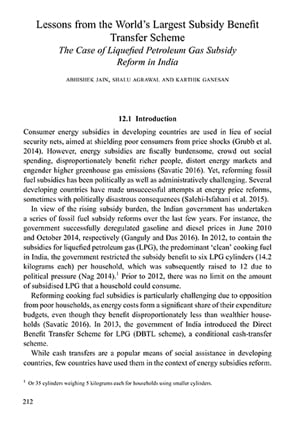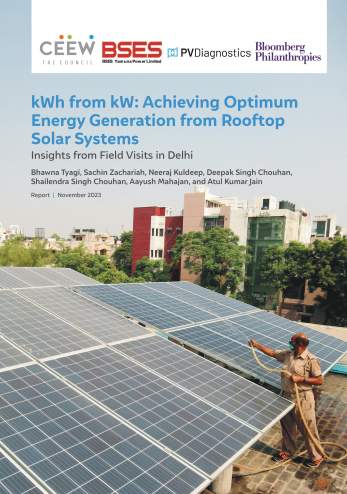



Abhishek Jain, Shalu Agrawal, Karthik Ganesan
August 2018 | Energy Transitions
Suggested Citation: Jain, A, S Agrawal, k Ganesan. 2018. "Lessons from the World’s Largest Subsidy Benefit Transfer Scheme. In The Politics of Fossil Fuel Subsidies and their Reform, edited by J. Skovgaard, 212-228. Cambridge: Cambridge University Press.
This book chapter, published in ‘The Politics of Fossil Fuel Subsidies and their Reform’, examines the performance of the Direct Benefit Transfer of LPG (DBTL) scheme. The chapter focuses on three key questions – (i) How successful was the implementation process of the scheme, and what were the gaps in implementation, if any? (ii) How successful was the scheme in achieving its stated objectives? (iii) Why did the DBTL scheme achieve this degree of success?
In the pursuit of answering these questions, the authors focused on key actors and stakeholder groups, and strategies used to design and administer the scheme while overcoming challenges during the scheme’s implementation. As part of the assessment process, authors used mixed-methods approach, comprising structured telephonic survey of 1,270 households and 92 LPG distributors, semi-structured telephonic interviews with implementation officers and bank managers, and unstructured in-person interviews with senior management of the oil marketing companies and government officials.
The following lessons could be useful for designing fossil fuel subsidy reforms in other contexts and countries.
Political leadership and framing of the narrative is crucial: Strong leadership from the national government, timely recognition of the opportunity for reform, and smart framing of the narrative have been prime factors behind the successful and smooth implementation of the world’s largest cash transfer scheme, as it infused a momentum throughout the range of actors along the LPG supply chain involved in the implementation process.
Successful institutional coordination: The scheme’s implementation process involved multiple stakeholders, including several government ministries, the entire LPG retail supply chain, the banking sector and the district-level administration. An elaborate multi-tiered structure of project management teams was formed to facilitate coordination and to enable troubleshooting during the implementation.
Exploiting motivations at the individual level and supporting capacity building important: Giving individual ownership and responsibility to stakeholders is instrumental in the implementation of such large-scale public programmes. The senior and middle managers of the OMCs, along with the officials and Minister at the Ministry of Petroleum and Natural Gas, were the guardian officers for one district each. This created a sense of responsibility for effective implementation of the scheme in their respective districts.
Learning from past experience necessary to avoid failures: The modified DBTL scheme incorporated insights from a review of the scheme’s first round of implementation. The review included an alternative enrolment procedure which addressed the politically sensitive issue of exclusion of LPG consumers lacking an Aadhar number and also identified the difficulties faced by different stakeholders. Reviewing reform programmes and incorporating feedback of key stakeholders, particularly end-consumers, improved the scheme design and implementation process.
Leveraging existing systems and schemes: The DBTL scheme rested on the effective use of several other government schemes and efforts. While there was a clear convergence of past and ongoing schemes, sustained efforts continued to improve banking infrastructure and services for all households, particularly as rural and/or economically poor households constitute majority of future LPG adopters in India.
Strong emphasis on awareness generation: The DBTL scheme was well-publicised through an intensive information education campaign comprising advertising through different media and direct outreach to consumers through text messages, calls and public announcements.
The scheme’s implementation has been largely successful indicated by very low proportion of households facing difficulties during enrolment and also in limiting the diversion of subsidised commodity to unintended uses. However, there remain gaps in cash transfer efficiency, as well as associated information flow. Improvements pertaining to human resource management, standardisation of protocols and consumer awareness are required. There must be emphasis on financial inclusion and access to banking services to ensure that DBTL would not pose additional barriers to LPG adoption, particularly in rural India.
The Cambridge University Press book is the first of its kind academic collection of analyses delving deep into the politics and political economy of the fossil fuel subsidies. The book understands the conceptual aspects of fossil fuel subsidies, offers valuable insights for international community to enable fossil fuel subsidies reforms and explores the role of various intergovernmental and non-governmental institutions in promoting fossil fuel subsidy reform at the international level.

Enabling a Circular Economy in India’s Solar Industry
Akanksha Tyagi, Ajinkya Kale, Neeraj Kuldeep

Community Solar for Advancing Power Sector Reforms and the Net-Zero Goals
Bhawna Tyagi , Neeraj Kuldeep

Mapping India’s Residential Rooftop Solar PotentialA bottom-up assessment using primary data
Sachin Zachariah, Bhawna Tyagi and Neeraj Kuldeep

Promoting the Use of LPG for Household Cooking in Developing Countries
Abhishek Kar, Roshan Wathore, Arunabha Ghosh, Shruti Sharma, Emily Floess, Andrew Grieshop, Rob Bailis, and Nitin Labhasetwar


